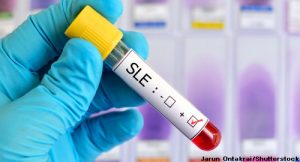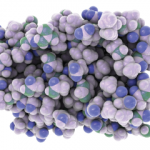Edited 11/8/2022 to correct the references to the BLISS-BELIEVE and BEAT LUPUS trials.
 EULAR 2022 (VIRTUAL)—The past few years have seen the U.S. Food & Drug Administration approve three new therapies to treat systemic lupus erythematosus (SLE) and/or lupus nephritis. The rheumatology community is rightfully excited about the potential of belimumab, anifrolumab and voclosporin, but what else is new for SLE?
EULAR 2022 (VIRTUAL)—The past few years have seen the U.S. Food & Drug Administration approve three new therapies to treat systemic lupus erythematosus (SLE) and/or lupus nephritis. The rheumatology community is rightfully excited about the potential of belimumab, anifrolumab and voclosporin, but what else is new for SLE?
At the European Alliance of Associations for Rheumatology (EULAR) European Congress of Rheumatology 2022, Thomas Dörner, MD, Department of Medicine and Department of Rheumatology and Clinical Immunology, Charité-Berlin University of Medicine, and German Rheumatism Research Center (DRFZ), Berlin, shared updates on SLE pathogenesis and novel therapies.
Where We Are
In recent years, we’ve seen new SLE management guidelines emerge from many different parts of the world (e.g., Europe, Canada, the U.K., Latin America). All share the same general recommendations: Glucocorticoid treatment should be limited in dose and duration. Antimalarials are strongly recommended for all patients with SLE. For persistently active and/or life-threatening disease, disease-modifying anti-rheumatic drugs and biologic treatments should be used according to organ manifestation. And comorbidities, such as hypertension, should be actively treated.1
We’ve also seen pushes to define both low disease activity and remission in SLE.2,3 With better control of disease activity, we hope to delay damage accrual, disability and premature death. We are moving closer than ever to these goals, but we aren’t quite there.
In the Toronto Lupus Clinic, between 1971 and 2013, people with SLE lost about 23 years of life compared with controls, and all-cause and cause-specific standardized mortality rates decreased over time.4 In a 2018 analysis of U.S. Centers for Disease Control and Prevention (CDC) data, SLE remained among the top 10 causes of death among young women, with non-white patients most severely affected.5
A longitudinal cohort study published in March 2022 showed that failure to achieve a low lupus disease activity state (LLDAS) and cumulative glucocorticoid doses are significantly associated with morbidity and mortality in SLE. Never achieving LLDAS was associated with a near fivefold risk of death after adjustment for confounders (adjusted mortality rate hazard ratio 4.98 [95% confidence interval 2.07–12.0]; P<0.001).2,6
“The challenge for us in 2022 is to improve SLE treatment outcomes to prevent damage and mortality,” Dr. Dörner said. “To do this, we need to employ advanced treatment options and treat to target to minimize glucocorticoid burden.”
Recent Advances in Pathogenesis
Dr. Dörner highlighted a few new insights into SLE pathogenesis, noting that to discuss them all would take far longer than time allotted.
In SLE, a positive feed-forward loop of adaptive and innate immune activation is comprised of two main signatures: the type I interferon (IFN) signature and the B cell/plasma cell/BLyS signature.
“To which extent these two faces are interrelated—and whether they share one common brain—is not yet clear, but it’s clear that they’re communicating with each other,” he said.7
For many years, we’ve also known anti-IFN antibodies can affect the IFN signature in SLE. Anti-type I and II IFN antibodies are found in 27% of SLE patients.8
“The important point to take away here is that in about half of the patients with SLE who have anti-IFN antibodies, those antibodies are neutralizing and down-modulate the IFN signature,” Dr. Dörner said. “So to what extent do anti-type I IFN antibodies affect the one-third of lupus patients with low IFN signatures? This is the next question to answer.”9
‘The challenge for us in 2022 is to improve SLE treatment outcomes to prevent damage and mortality. To do this, we need to employ advanced treatment options and treat-to-target to minimize glucocorticoid burden.’—Dr Dörner
Promising New Targets
Dr. Dörner highlighted several potential new therapeutic targets in SLE. Antibodies directed against blood dendritic cell antigen 2 (BDCA2), a unique plasmacytoid dendritic cell (pDC)-specific receptor, inhibits but doesn’t deplete pDCs. It also reduces the production of type I IFN and other inflammatory mediators.
“There were very promising results from the phase 2 LILAC trial last year. What I found most interesting was the [positive] effect on tender and swollen joints,” he said. The drug was also associated with a positive SLE Responder Index (SRI-4) response compared with placebo.10
Iberdomide also holds promise in SLE. Ikaros and Aiolos are two key transcription factors in immune cell development and homeostasis that are linked to genetic risk factors for SLE. Iberdomide promotes the proteasomal degradation of Ikaros and Aiolos.
Dr. Dörner said, “Iberdomide shifts the transcriptional program. It reduces B-cell activation and autoantibody production, targets pDCs and reduces the type I IFN signature. And it simultaneously enhances the function of regulatory T cells.”
Iberdomide at the highest dose tested met the primary endpoint of SRI-4 clinical response at week 24 in a recent phase 2 study.11
“One of the interesting new questions is to what extent ‘deeper’ tissue depletion or co-targeting of plasma cells in the bone marrow may result in greater efficacy in SLE,” Dr. Dörner said.
He mentioned two new targets: CD38 (cluster of differentiation 38), which is expressed by all bone marrow plasma cells, and CD19, which is expressed by only some bone marrow plasma cells.12
Investigators have recently made use of both targets in refractory SLE (Systemic Lupus Erythematosus Disease Activity Index [SLEDAI] >20). Case reports describing the efficacy of CD19-targeted chimeric antigen receptor (CAR) T cells and daratumumab, a multiple myeloma drug that targets CD38, were published in the New England Journal of Medicine in 2021 and 2020, respectively.13,14
Likely Not the Answer
We’ve seen disappointing trials in SLE, as well. In 2020, phase 3 studies of ustekinumab were discontinued given lack of efficacy.15 In 2022, phase 3 baricitinib studies were discontinued given discordant results.16
Data remain inconclusive regarding the sequential use of belimumab and rituximab: BEAT-LUPUS was a phase 2, randomized, double-blind, placebo-controlled, superiority trial in which patients received rituximab, followed by belimumab four to eight weeks later. Belimumab after rituximab significantly reduced serum immunoglobulin G anti-double stranded-deoxyribonucleic acid (IgG anti-dsDNA) levels and reduced the risk of severe SLE flare. However, in the follow-up, phase 3 trial (BLISS-BELIEVE), the primary end point was not met because there were no statistically significant improvements in disease control as measured by SLEDAI-2K score.17,18
“We’re not sure whether the books can be closed yet,” Dr. Dörner said.
Conclusion
Dr. Dörner concluded his talk on a hopeful note.
“Control of SLE disease activity, glucocorticoid sparing and damage prevention are becoming realistic goals,” he said. “Successful translation of SLE key signatures provide the basis for future developments, including restoring immune homeostasis.”
Samantha C. Shapiro, MD, is an academic rheumatologist and an affiliate faculty member of the Dell Medical School at the University of Texas at Austin. She is also a member of the ACR Insurance Subcommittee.
References
- Fanouriakis A, Kostopoulou M, Alunno A, et al. 2019 update of the EULAR recommendations for the management of systemic lupus erythematosus. Ann Rheum Dis. 2019 Jun;78(6):736–745.
- Golder V, Kandane-Rathnayake R, Huq M, et al. Lupus low disease activity state as a treatment endpoint for systemic lupus erythematosus: A prospective validation study. Lancet Rheumatol. 2019 Sep 6;1(2).
- van Vollenhoven RF, Bertsias G, Doria A, et al. 2021 DORIS definition of remission in SLE: Final recommendations from an international task force. Lupus Sci Med. 2021 Nov;8(1):e000538.
- Tselios K, Gladman DD, Sheane BJ, et al. All-cause, cause-specific and age-specific standardised mortality ratios of patients with systemic lupus erythematosus in Ontario, Canada over 43 years (1971–2013). Ann Rheum Dis. 2019 Jun;78(6):802–806.
- Yen EY, Singh RR. Brief report: Lupus—an unrecognized leading cause of death in young females: A population-based study using nationwide death certificates, 2000–2015. Arthritis Rheumatol. 2018 Aug;70(8):1251–1255.
- Kandane-Rathnayake R, Louthrenoo W, Hoi A, et al. ‘Not at target’: prevalence and consequences of inadequate disease control in systemic lupus erythematosus—a multinational observational cohort study. Arthritis Res Ther. 2022 Mar 14;24(1):70.
- Rose T, Dörner T. Drivers of the immunopathogenesis in systemic lupus erythematosus. Best Pract Res Clin Rheumatol. 2017 Jun;31(3):321–333.
- Morimoto AM, Flesher DT, Yang J, et al. Association of endogenous anti-interferon-α autoantibodies with decreased interferon-pathway and disease activity in patients with systemic lupus erythematosus. Arthritis Rheum. 2011 Aug;63(8):2407–2415.
- Gupta S, Tatouli IP, Rosen LB, et al. Distinct functions of autoantibodies against interferon in systemic lupus erythematosus: A comprehensive analysis of anticytokine autoantibodies in common rheumatic diseases. Arthritis Rheumatol. 2016 Jul;68(7):1677–1687.
- van Vollenhoven R, Furie R, Kalunian K, et al. Demonstrated a consistent therapeutic effect on sri-4 response across subgroups of participants with systemic lupus erythematosus in the lilac phase 2 study (POS0698 BIIB059). Ann Rheum Dis. 2021;80(suppl 1: 597–598.
- Merrill JT, Werth VP, Furie R, et al. Phase 2 trial of iberdomide in systemic lupus erythematosus. N Engl J Med. 2022 Mar 17;386(11):1034–1045.
- Mei HE, Wirries I, Frölich D, et al. A unique population of IgG-expressing plasma cells lacking CD19 is enriched in human bone marrow. Blood. 2015 Mar 12;125(11):1739–1748.
- Ostendorf L, Burns M, Durek P, et al. Targeting CD38 with daratumumab in refractory systemic lupus erythematosus. N Engl J Med. 2020 Sep 17;383(12):1149–1155
- Mougiakakos D, Krönke G, Völkl S, et al. CD19-targeted CAR T cells in refractory systemic lupus erythematosus. N Engl J Med. 2021 Aug 5;385(6):567–569.
- News release: Janssen announces discontinuation of phase 3 LOTUS study evaluating ustekinumab in systemic lupus erythematosus. Janssen Pharmaceutical Companies of Johnson & Johnson. 2020 Jun 26.
- News release: Updates on Olumiant (baricitinib) phase 3 lupus program and FDA review for atopic dermatitis. Eli Lilly and Company. 2022 Jan 28.
- Shipa M, Embleton-Thirsk A, Parvaz M, et al. Effectiveness of belimumab after rituximab in systemic lupus erythematosus a randomized controlled trial. Ann Intern Med. 2021 Dec;174(12):1647–1657.
- Aranow C, Allaart C, Amoura Z, et al. Efficacy and safety of subcutaneous belimumab (BEL) and rituximab (RTX) sequential therapy in patients with systemic lupus erythematosus: the Phase 3, randomized, placebo-controlled BLISS-BELIEVE study [abstract: L13]. Arthritis Rheumatol. 2021 Oct;73 (suppl 10).

